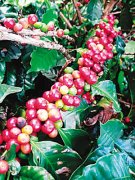Indian coffee mild coffee taste boutique coffee Asian boutique coffee flavor
The term "fine coffee" was first put forward by Ms. Knudsen of the United States in Coffee and Tea magazine. At that time, Ms. Knudsen, as a coffee buyer of B.C. Ireland in San Francisco, was very dissatisfied with the neglect of the quality of raw coffee in the industry, and even some big roasters mixed a large amount of Robesda beans in the comprehensive beans, so she put forward the concept of fine coffee to advocate the improvement of the quality of the industry. This term is used to describe coffee beans with distinctive flavor characteristics that grow in a special environment. Its use in international coffee conferences makes it spread rapidly.

India (India) aroma 3.5 minutes brightness 4 minutes mellow 4 minutes flavor 4.5 points aftertaste 4 points
Suitable for baking: Full city/Espresso full city, if you want to get a thick flavor like dark chocolate, you can even enter the dense area of the second explosion!
The taste of Indian coffee is very mild, very low in intensity and acidity, with some spice and, of course, the common local flavor of Asian beans. India is usually used to blend into Espresso recipes. In fact, Indian beans taste like Sulawesi beans or Sumatra beans, but not that thick. Indian coffee does not sell well in the international market, and the main markets are in India. Indian beans treated in the sun are called Cherry, Arabica beans washed in water are called Plantation Arabica, and Robusta in water are called Parchment Robusta. In addition, rainy beans and aged beans increase the consistency of coffee and dark chocolate-flavored aged beans. Coffee beans have also begun to amaze coffee critics in India this year, most of which come from independent coffee farms.
Important Notice :
前街咖啡 FrontStreet Coffee has moved to new addredd:
FrontStreet Coffee Address: 315,Donghua East Road,GuangZhou
Tel:020 38364473
- Prev

Boutique coffee beans from manors in Papua New Guinea
The term "fine coffee" was first put forward by Ms. Knudsen of the United States in Coffee and Tea magazine. At that time, Ms. Knudsen, as a coffee buyer at B.C. Ireland in San Francisco, was very dissatisfied with the neglect of the quality of raw coffee in the industry, and even some big roasters mixed a large amount of Robesda beans in the comprehensive beans, so she put forward the concept of boutique coffee.
- Next

Introduction of Panamanian Coffee Variety-Pokuit Flower Butterfly Coffee beans
Coffee varieties: Geisha, Catuai, Caturra planting altitude: 1400-1700m annual rainfall: 3200 mm average temperature: about 14-25 ℃ soil types: volcanic soil classification standard: SHB treatment method: washing method: manual harvest related certification: Nram A raw bean specification: 18 mesh harvest year: 2015 cup test results: Apple, Potato, Maple syrup, Le
Related
- Does Rose Summer choose Blue, Green or Red? Detailed explanation of Rose Summer Coffee plots and Classification in Panamanian Jade Manor
- What is the difference between the origin, producing area, processing plant, cooperative and manor of coffee beans?
- How fine does the espresso powder fit? how to grind the espresso?
- Sca coffee roasting degree color card coffee roasting degree 8 roasting color values what do you mean?
- The practice of lattes: how to make lattes at home
- Introduction to Indonesian Fine Coffee beans-- Java Coffee producing area of Indonesian Arabica Coffee
- How much will the flavor of light and medium roasted rose summer be expressed? What baking level is rose summer suitable for?
- Introduction to the characteristics of washing, sun-drying or wet-planing coffee commonly used in Mantenin, Indonesia
- Price characteristics of Arabica Coffee Bean Starbucks introduction to Manning Coffee Bean Taste producing area Variety Manor
- What is the authentic Yega flavor? What are the flavor characteristics of the really excellent Yejasuffi coffee beans?

